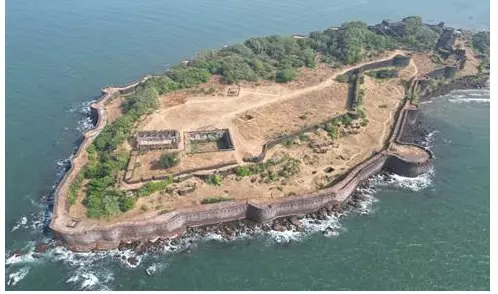Syllabus:
GS1: Indian Culture – Salient aspects of Art Forms, Literature and Architecture from ancient to modern times.
Context:
At the 47th World Heritage Committee session, India’s 2024–25 nomination, ‘Maratha Military Landscapes of India’, was added to the UNESCO World Heritage List.
More on the News
- It becomes India’s 44th property to receive this recognition.
- The Maratha Military Landscape of India was nominated under criteria (iv) and (vi), recognizing their exceptional testimony to a living cultural tradition, their architectural and technological significance, and their deep associations with historic events and traditions.
- The purpose of including these heritage sites in UNESCO’s list is to preserve and promote shared heritage based on Outstanding Universal Values found in cultural, natural as well as mixed properties across 196 countries.
- On its part, India became a member of the World Heritage Committee from 2021-25.
- The Moidams of Charaideo, Assam, were inscribed in the World Heritage List at the 46th Session of the World Heritage Committee held in New Delhi.
- India ranks 6th globally and 2nd in the Asia Pacific Region for the greatest number of World Heritage Sites.
World Heritage Convention:
- It is formally known as the “Convention Concerning the Protection of the World Cultural and Natural Heritage,” which was adopted by UNESCO in 1972.
- 196 nations have ratified the World Heritage Convention, 1972.
- It establishes a framework for identifying, protecting, and preserving cultural and natural sites of “outstanding universal value”.
- This convention is a legally binding international agreement that guides the work of the World Heritage.
- India has 62 sites in the Tentative List of the World Heritage, which is a mandatory threshold for any site to be considered as a World Heritage property in the future.
- Every year, each State Party may propose just one site for consideration by the World Heritage Committee for inscription on the World Heritage List.
Maratha Military Landscapes of India
- Dating from the 17th to 19th centuries, these twelve forts showcase the Maratha Empire’s strategic and architectural brilliance.
- The selected sites include Salher, Shivneri, Lohgad, Khanderi, Raigad, Rajgad, Pratapgad, Suvarnadurg, Panhala, Vijaydurg, and Sindhudurg in Maharashtra, along with Gingee Fort in Tamil Nadu.
- While Shivneri fort, Lohgad, Raigad, Suvarnadurg, Panhala fort, Vijaydurg, Sindhudurg and Gingee fort are protected under the Archaeological Survey of India.
- The Salher fort, Rajgad, Khanderi fort and Pratapgarh are protected by the Directorate of Archaeology and Museums, Government of Maharashtra.
- Spread across varied terrains, these forts reflect strategic use of geography and form a unified military landscape showcasing India’s adaptive fortification traditions.
- Salher, Shivneri, Lohgad, Raigad, Rajgad, and Gingee are situated in hilly terrains and are therefore known as hill forts.
- Pratapgad, nestled within dense woods, is classified as a hill-forest fort. Panhala, located on a plateaued hill, is a hill-plateau fort.
- Vijaydurg, positioned along the shoreline, is a notable coastal fort, while Khanderi, Suvarnadurg, and Sindhudurg, surrounded by the sea, are recognized as island forts.
Shivaji Hill forts
- Hill forts were central to Maratha strategy, as their rugged terrain, flanked by the Arabian Sea, Konkan plains, and Western Ghats, favoured guerrilla warfare over large-scale battles typical of northern India.
- Maratha icon Shivaji was born and raised in Shivneri, a typical Western Ghats hill fort gifted to his grandfather by the Sultan of Ahmadnagar for military service.
- Growing up in the hills and valleys around Pune, Shivaji understood the salience of hill forts in controlling the land.
- Over his storied life, he captured multiple such forts, including Torna, Rajgadh, Sinhagadh and Purandar.
- Early on, Shivaji saw forts as key to power in the Deccan. His strategy focused on capturing, repairing, and building forts in strategic hilltop locations.
- Warfare in the rugged terrain hindered large armies, so Shivaji adopted strategies that diverged from the conventional military tactics of the time.
Source: PIB

